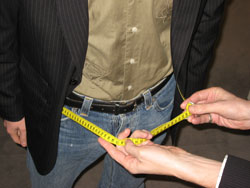According to experts, waist measure can say more about somebody’s state of health than the overall body weight. Having a lot of fat around the stomach increases the risk that a person will suffer from diabetes and heart disease with a factor four. A cause of this might be that fat cells around the waist pump out proteins, hormones and chemicals that can damage the insulin system. The risks are particularly high for persons with a waist measure of more than 35 inches (women) or 40 inches (men). The risks for these persons are equally high as for massively overweight persons.
 Since persons tend to have different body shapes, a way of measuring the waist has been developed that does more justice to physical shapes by comparing the measure of the waist and the hips. The hips should be measured at their largest spot, that is over the buttocks. The waist should be measured at its smallest place, which is the navel. The measuring tape should not be pulled tightly, but should touch the body. After this the waist measurement should be divided with the hip measurement. If the ratio is more than 0.8 for women or 0.95 for men the risk of health problems is high. The ideal ratio seen from a health perspective is around 0.7 for women and a little less than 0.9 for men.
Since persons tend to have different body shapes, a way of measuring the waist has been developed that does more justice to physical shapes by comparing the measure of the waist and the hips. The hips should be measured at their largest spot, that is over the buttocks. The waist should be measured at its smallest place, which is the navel. The measuring tape should not be pulled tightly, but should touch the body. After this the waist measurement should be divided with the hip measurement. If the ratio is more than 0.8 for women or 0.95 for men the risk of health problems is high. The ideal ratio seen from a health perspective is around 0.7 for women and a little less than 0.9 for men.
In Zhineng Qigong we use several different exercises that can help us relax the waist (especially the small of the back) and reduce the waist measure.
